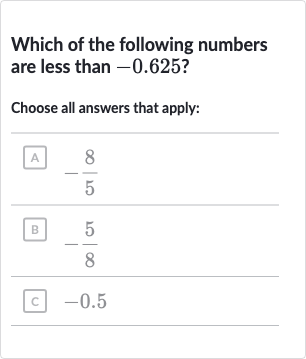Full solution
Q. Which of the following numbers are less than . ?Choose all answers that apply:(A) (B) (C) .
- Convert to Decimal Form: To compare the numbers, we need to express them in a common format. Let's convert the fractions to decimal form.A: B: C:
- Compare to : Now let's compare each number to .A: is less than because the more negative a number, the smaller it is.B: is equal to , so it is not less than .C: is greater than because is closer to zero.
- Identify Numbers Less Than : We can now identify which numbers are less than .
A: (or ) is less than .
B: is not less than because it is equal to .
C: is not less than .
More problems from Domain and range of relations
QuestionGet tutor help

